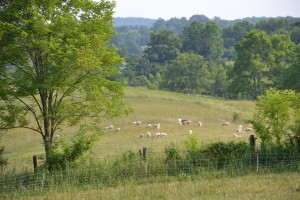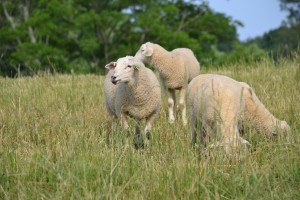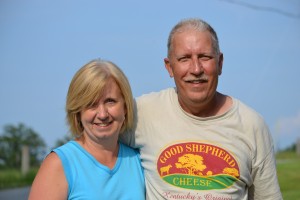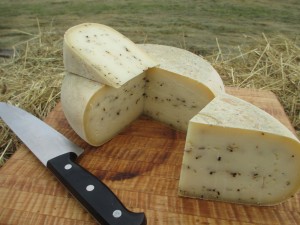Sheep cheese maker is unique
Posted on Mar 1, 2015
History suggests that before people were milking cows, they may have been milking goats. And even before that, sheep.
Sheep’s milk is very nutritious with a higher solids content than most other types of milk, meaning it lends itself very favorably to making cheese.
Unless you haunt the gourmet cheese shops and boutique markets, you may not be too familiar with sheep cheese, most of which is made in Europe. But for the last five years or so, a small farm in Bath County, Kentucky has been quietly building a following with smooth, rich cheese patterned after a cheese that has been produced in the Pyrenees Mountains for some 40 centuries.

So how did the product of Good Shepherd Cheese find its way 4,500 miles across the Atlantic Ocean to the verdant rolling hills of eastern Kentucky? It’s a story of deep personal faith and a search for a more difficult, yet rewarding, way of life.
Sanford Dotson turned his back on a successful career with Toyota Motor Manufacturing in Georgetown to pursue a more fundamental lifestyle. “I’d like to say it was something we decided to do,” said Dotson, “but I really don’t feel like we had much choice in the matter.” While his wife Colleen had been a Christian most of her life, Sanford was still new in his faith when the Dotsons began to feel a need to change their priorities.
“Money had always been important to me,” admits Dotson. “Saving for retirement and having the log home we always wanted suddenly didn’t seem that important anymore.”
“You shouldn’t take your 401-k money and your pension money and invest it in something like this, but that’s what we’ve done.”

The Dotsons and older son Josh attended a food show, where they meet artisan goat cheese-maker Susan Miller of Lexington, who encouraged them to look into the manufacture of sheep cheese which was rapidly rising in popularity in gourmet and local food circles. It was an idea that resonated with the family who had already decided they wanted to raise sheep. Miller knew some of the work that lay ahead for the Dotsons. Her Bleugrass Chevre was the first goat dairy certified in Kentucky.
But, the learning curve was steep. With no experience in keeping sheep, building a dairy or making cheese, the Dotsons immersed themselves into the idea and began to search for the information and resources they would require to accomplish their goal. “Everything that we tried to do on our own to get out here on the farm and try to make this work failed,” Dotson observed. “When we took the unconventional approach, what we felt we were being led to do, it always worked out.”
The Dotsons soon learned that everything about their new venture was special and required them to seek out very specialized assistance. “You can’t just go over to your neighbor and buy a few lambs to get started,” notes Sanford. The first East Friesian sheep the Dotsons obtained were from David Major of Vermont Shepherd Dairy, the oldest sheep cheese operation in the United States. Major delivered the first six pregnant ewes to the Dotsons and they were on their way.
The East Friesian breed originated in Holland and northern Germany and are the most widely used dairy sheep in the United States. According to Susan Schoenian, Sheep & Goat Specialist at the University of Maryland's Western Maryland Research & Education Center, the East Friesian is considered to be the heaviest milking breed of sheep in the world. It is analogous to the Holstein cow, which came from the same region of Europe. The average milk production of the East Friesian can exceed 1,000 lbs. of milk during a 220 to 240-day lactation.

Shortly after the first sheep arrived, the Dotsons attended the University of Kentucky’s first cheese making school, held at Susan Miller’s farm. With the knowledge acquired at the school, modifications were made to a centuries old Pyrenean recipe to develop the smooth, mild cheese that would become Good Shepherd’s flagship product.
Seeking to assure the freshest product, Good Shepherd cheese is made in small 35 gallon batches 3 times each week from March through October.
After the milk was flowing and the first experimental batches of cheese were made, the biggest challenge was yet to come. Milking could not continue in the converted tobacco barn and production could no longer be limited to the Dotson’s kitchen. A facility had to be built to meet manufacturing needs and comply with government health and sanitation requirements necessary to receive certification. That’s where Frank Jackson came in.
Jackson is a milk inspector for Kentucky’s Milk Safety Branch, located in the state Cabinet for Health and Family Services. He assisted the Dotsons through each phase of design and construction of the physical plant. “Frank was very encouraging and helpful, giving us the information we needed ahead of time so that time and money could be saved by doing things right the first time.” says Sanford.
It’s been a long and sometimes difficult process for the Dotsons, and while it’s not over yet, Sanford and Colleen hold on to the faith and trust with which they began the journey.
“We want to be good shepherds to our sheep, but we know that we have a Good Shepherd watching over us.”
Tagged Post Topics Include: Bath County, Bluegrass Chevre, Cabinet for Health and Family Services, cheese, Christian, Colleen Dotson, Cows, David Major, Frank Jackson, Georgetown, Good Shepard Cheese, Gourmet, Josh Dotson, Kentucky Milk Safety Branch, Lexington, Milk, Pyrenees Mountains, Sanford Dotson, Sheep, Susan Miller, Susan Schoenian, Toyota Motor Manufacturing, University of Maryland's Western Maryland Research & Education Center, Vermont Shepherd Dairy
Comments